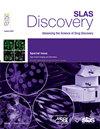使用温度相关强度变化(TRIC)技术发现TREM2:一种概念验证的高通量筛选方法
IF 2.7
4区 生物学
Q2 BIOCHEMICAL RESEARCH METHODS
引用次数: 0
摘要
骨髓细胞上表达的触发受体2 (TREM2)是一种涉及神经退行性疾病和癌症的免疫调节受体。根据不同的背景,TREM2激动剂或抑制剂具有治疗潜力。迄今为止,大多数靶向trem2的策略都集中在单克隆抗体(mab)上,这面临着诸如组织穿透性差和潜在的免疫原性副作用等局限性。为了克服这些挑战并扩大TREM2靶向药物的化学空间,我们开发了一个高通量筛选(HTS)平台来鉴定新的小分子TREM2结合物。利用384孔板(NanoTemper Dianthus)格式的温度相关强度变化(TRIC)技术,我们筛选了两个包含超过1200个分子的集中化合物文库。从这个筛选中,鉴定了18个初步靶点(1.44%的命中率),随后通过使用微尺度热电泳(MST)的剂量反应结合研究进行了验证,产生了4个验证靶点(0.32%的命中率),其结合亲和力在高到中等微摩尔范围内(例如,T2337, KD = 22.4µM)。利用表面等离子体共振(SPR)进一步验证了T2337的结合。此外,我们评估了所有四种被验证的hit的功能活性,在共表达人TREM2及其接头蛋白DAP12的HEK293细胞中测量TREM2介导的Syk磷酸化。这些发现为发现小分子TREM2调节剂建立了一个强大的、可扩展的平台,并为更广泛的靶向TREM2的HTS活动提供了概念证明。本文章由计算机程序翻译,如有差异,请以英文原文为准。

TREM2 hit discovery using temperature-related intensity change (TRIC) technology: A proof-of-concept high-throughput screening approach
Triggering receptor expressed on myeloid cells 2 (TREM2) is an immunomodulatory receptor implicated in both neurodegenerative diseases and cancer. Depending on the context, TREM2 agonists or inhibitors hold therapeutic potential. To date, the majority of TREM2-targeted strategies have centered on monoclonal antibodies (mAbs), which face limitations such as poor tissue penetration and potential immunogenic side effects. To overcome these challenges and expand the chemical space for TREM2-targeting agents, we developed a high-throughput screening (HTS) platform to identify novel small molecule TREM2 binders. Using temperature-related intensity change (TRIC) technology in a 384-well plate format (NanoTemper Dianthus), we screened two focused compound libraries comprising over 1,200 molecules. From this screen, 18 preliminary hits (1.44 % hit rate) were identified and subsequently validated by dose-response binding studies using microscale thermophoresis (MST), yielding four validated hits (0.32 % hit rate) with binding affinities in the high to medium micromolar range (e.g., T2337, KD = 22.4 µM). The binding of the top hit, T2337, was further validated using surface plasmon resonance (SPR). Additionally, we assessed the functional activity of all four validated hits in a cellular assay measuring TREM2-mediated Syk phosphorylation in HEK293 cells co-expressing human TREM2 and its adaptor protein DAP12. These findings establish a robust and scalable platform for the discovery of small molecule TREM2 modulators and serve as a proof-of-concept for broader HTS campaigns targeting TREM2.
求助全文
通过发布文献求助,成功后即可免费获取论文全文。
去求助
来源期刊

SLAS Discovery
Chemistry-Analytical Chemistry
CiteScore
7.00
自引率
3.20%
发文量
58
审稿时长
39 days
期刊介绍:
Advancing Life Sciences R&D: SLAS Discovery reports how scientists develop and utilize novel technologies and/or approaches to provide and characterize chemical and biological tools to understand and treat human disease.
SLAS Discovery is a peer-reviewed journal that publishes scientific reports that enable and improve target validation, evaluate current drug discovery technologies, provide novel research tools, and incorporate research approaches that enhance depth of knowledge and drug discovery success.
SLAS Discovery emphasizes scientific and technical advances in target identification/validation (including chemical probes, RNA silencing, gene editing technologies); biomarker discovery; assay development; virtual, medium- or high-throughput screening (biochemical and biological, biophysical, phenotypic, toxicological, ADME); lead generation/optimization; chemical biology; and informatics (data analysis, image analysis, statistics, bio- and chemo-informatics). Review articles on target biology, new paradigms in drug discovery and advances in drug discovery technologies.
SLAS Discovery is of particular interest to those involved in analytical chemistry, applied microbiology, automation, biochemistry, bioengineering, biomedical optics, biotechnology, bioinformatics, cell biology, DNA science and technology, genetics, information technology, medicinal chemistry, molecular biology, natural products chemistry, organic chemistry, pharmacology, spectroscopy, and toxicology.
SLAS Discovery is a member of the Committee on Publication Ethics (COPE) and was published previously (1996-2016) as the Journal of Biomolecular Screening (JBS).
 求助内容:
求助内容: 应助结果提醒方式:
应助结果提醒方式:


